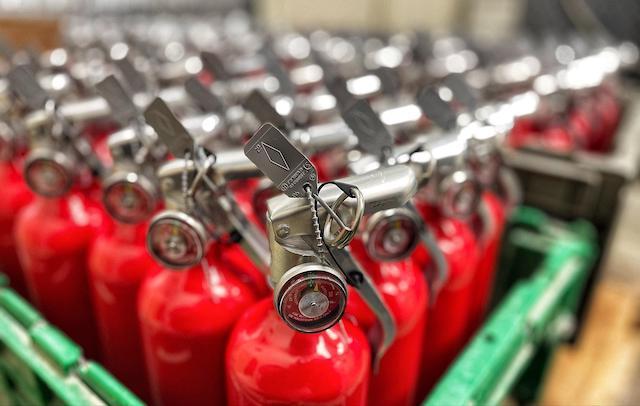Etihad Engineering Sees Increasing Demand For Fire-Suppression Mods

The gradual elimination of conventional liquid for fire suppression is causing an uptick in modifications. Ahmad Rajei, acting vice president design, engineering and innovation at Etihad Engineering, is seeing an increasing demand for these changes, “especially for the portable fire extinguisher replacement, due to the fast-approaching end date, which is Dec. 31, 2025.”
Since the 1990s, the International Civil Aviation Organization has been seeking replacements of halon-based fire-suppression in aircraft. The pacing framework for many airlines and MROs is EASA’s schedule for eliminating halon on new aircraft and ending its use on existing EU-registered aircraft. For lavatories, halon had to be replaced in flying aircraft by 2019. The next hard deadline is for replacing halon in the portable fire extinguishers used to suppress fires in cockpits and cabins by the beginning of 2026.
“Historically, it has been difficult to replace them with alternative agents with lower ozone depletion potential, so critical uses or applications of halons have been accepted, subject to cut-off dates for new equipment and end dates,” Rajei explains.
Rajei says the imminent replacement of portable fire extinguishers can be done either at heavy checks or separately, but for a large fleet that needs replacement of extinguishers on many aircraft, it is advisable to start retrofits well before the coming deadline.
And modification challenges will be tougher for replacing halons in cargo compartments, fuel tanks, APUs, nacelles and dry bays, all of which must be retrofitted by 2040. Rajei worries that any alternative to halon systems will be much larger and heavier, posing problems for modification. He ticks off the factors that providers or users of alternatives to halon must consider: ozone depletion potential, global warming potential, atmospheric lifetime, toxicity, material compatibility, operating environment, system complexity, maintainability, volume and weight, and cleaning after discharge.
After selecting a suitable substitute for halon, Rajei says an operator will have to schedule the modification during a heavy check, as it will be more complex than the earlier replacement in lavatories or the imminent replacement in cockpits and cabins. Then a modification provider will have to be chosen.
To aid airlines or lessors looking for halon modifications, the Independent Aircraft Modifier Alliance recently launched a request for proposal service through which these companies can make a modification request, and IAMA will help find a high-quality service provider.
The modifications noted by Rajei appear concentrated mostly on passenger aircraft. Despite the boom in cargo conversions, fire-suppression mods are not attracting much current interest for cargo compartments in converted freighters. The lower decks of converted freighters usually already have active fire suppression from their service as passenger jets, but the main decks of converted freighters are not required by regulators to have active fire suppression.
“Boeing has seen some interest from customers regarding Class C compartments [which require active fire suppression],” notes Jens Steinhagen, director of Boeing freighter conversions. “However, the vast majority of our customers satisfy their operational needs with the Class E cargo compartment classification for their 737-800BCF and 767-300BCF main deck and lower hold cargo compartments.”
Class E cargo compartments are found only on all-cargo aircraft. Shutting off ventilating airflow to or within a Class E compartment can control a fire, and Class E compartments must have a liner and a smoke or fire detection system, but not active fire suppression systems.
FedEx, after a fire-caused emergency landing in 1996, eventually installed active fire suppression on the main deck cargo compartments of its MD-11Fs and 777Fs. But most other cargo carriers do not seem interested in going beyond regulatory requirements since it can be costly.
For example, Robert Convey, senior vice president of Aeronautical Engineers, is not seeing an increase in demand for additional fire suppression on any of his company’s five narrowbody or regional conversion products. Convey says it is very expensive to install fire suppression on main decks of cargo aircraft, given the volume that would need to be saturated in case of fire.
“It is hard to put a dollar figure on it, but safe to say the addition of the system would add multi-millions of dollars to the development cost and a few million to the recurring cost,” says Convey.
Due to passenger safety and regulations, the case is obviously stronger for main decks of 737-400 or 757-200 combi aircraft where half the main deck is for passenger and the other half is for freight. “In this case,” explains Convey, “the fire suppression system is designed and certified as part of the conversion STC process.”



